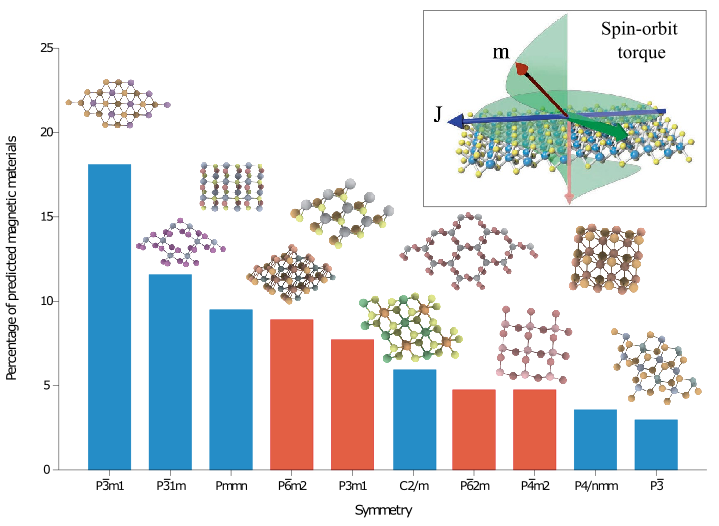Tuesday, 19 April 2022
Novel theoretical and computational tools for the design of future memory devices based on spin-orbit interactions
A theoretical analysis of magnetism, symmetry characteristics and spin transport in van der Waals materials provides guiding rules for benchmarking new tailor-made structures built by stacking different layers of atomic thickness. This work, published in ‘Nature Reviews Physics’, was carried out by researchers from the ICN2, the University College of London and the Johannes Gutenberg University of Mainz.

The incredible progress made in nanotechnology over several decades is opening unprecedented opportunities of manipulating matter at the atomic scale, to the point that researchers can create custom-made materials targeting specific applications. Such capability traces a path to disruptive technologies by enabling control of electronic behaviour, which could have a significant impact in fields such as electronics and communications.
Precise control of electron spin is required to build ultra-efficient and compact devices, which are essential for a sustainable future. Such control could be achieved by carefully engineering structures made of atomic-thin layers of different materials, exhibiting specific properties. A paper recently published in Nature Reviews Physics discusses how a deep understanding of magnetic and spin-orbit coupling phenomena occurring in bidimensional materials –specifically, van der Waals materials— can enable the design of a novel generation of spin devices.
This study was carried out by researchers from the Centre for Nanotechnology of the University College of London (UCL, UK), from the ICN2 Theoretical and Computational Nanoscience Group –led by ICREA Prof. Stephan Roche— and the Institute for Physics of the Johannes Gutenberg University of Mainz (JGU, Germany). First authors are Prof. Hidekazu Kurebayashi, professor of Condensed Matter Physics and Nanoelectronics at UCL, and Dr Jose Hugo García, postdoctoral researcher in Prof. Roche’s group.
Van der Waals (vdW) materials are layered solids that present strong in-plane bonding but weak interlayer interactions (van der Waals bonding). They are of great interest for the development of novel non-volatile memories –among other things— since these devices can be fabricated by employing vdW heterostructures as building blocks. In each memory cell, an information bit would be stored in the form of the relative orientation of two vdW magnetic layers. By making a current flow parallel to the bottom surface of the structure, it is possible to cause a switch of the magnetic momentum of the inferior layer (through a mechanism called spin-orbit torque) and, thus, write a digital value in the cell.
Monoatomic layers of magnetic vdW materials can be produced using large-scale fabrication methods (such as molecular beam epitaxy of catalytic vapor deposition) and, by developing wafer bonding techniques, unlimited stack combinations could be envisioned. But, how to choose the best configuration to meet the requirements? The article presents a global theoretical analysis, based on interface symmetry features, which provides guiding rules for researchers to design their layered structures according to the specific properties (and figures of merit) they are looking for.
“We are developing advanced computational schemes combining machine learning tools with linear scaling quantum transport algorithms to access quantitative information in realistic models of complex van der Waals heterostructures,” explains Dr Garcia. These tools will allow comparison with experimental data and optimization of spin devices performances, with the goal to develop non-volatile memory technologies based on the spin-orbit torque mechanism.
Image: Distributions of magnetic materials predicted using first-principle calculations as a function of their symmetry and illustration of spin–orbit torque mechanism. [Details in the paper.]
Reference article:
Hidekazu Kurebayashi, Jose H. Garcia, Safe Khan, Jairo Sinova & Stephan Roche, Magnetism, symmetry and spin transport in van der Waals layered systems. Nat Rev Phys 4, 150–166 (2022). DOI: 10.1038/s42254-021-00403-5

